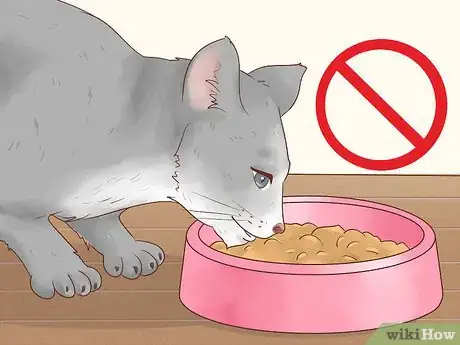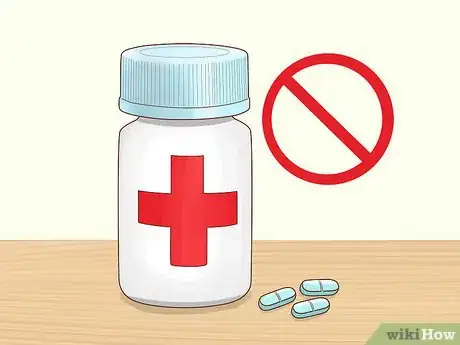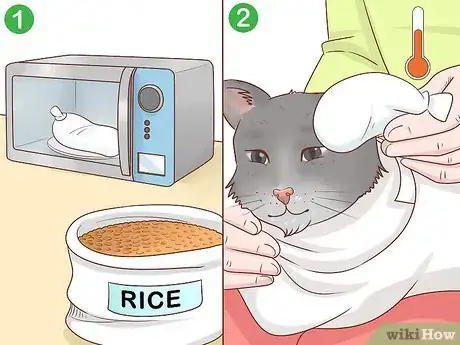This article was co-authored by Deanne Pawlisch, CVT, MA. Deanne Pawlisch is a Certified Veterinary Technician, who does corporate training for veterinary practices and has taught at the NAVTA-approved Veterinary Assistant Program at the Harper College in Illinois and in 2011 was elected to the board of the Veterinary Emergency and Critical Care Foundation. Deanne has been a Board Member of the Veterinary Emergency and Critical Care Foundation in San Antonio, Texas since 2011. She holds a BS in Anthropology from Loyola University and an MA in Anthropology from Northern Illinois University.
There are 8 references cited in this article, which can be found at the bottom of the page.
This article has been viewed 19,888 times.
Preparation for your cat’s blood test varies depending on why and where your cat is getting its blood tested. If your cat is scheduled for a routine blood test at the vet’s, keep it well hydrated and don’t feed it for about six hours prior to the blood test. If your cat is getting a blood test at the vet to diagnose a specific illness, your cat will probably need to fast for a longer period and probably won’t be able to take its regular medication. If you are planning to test your cat’s blood glucose at home, keep a positive attitude, gently restrain your cat, and warm their ear before testing their blood glucose.
Steps
Preparing Your Cat for a Routine Blood Test at the Vet
-
1Don’t feed your cat before the blood test. Your vet will probably recommend that you not feed your cat for about six hours before the test. This will prevent buildups of fat droplets in the blood that appear after eating. These fat droplets can interfere with the test’s outcomes.[1]
-
2Ensure your cat is not dehydrated. Your cat should not be dehydrated before the blood test, or it could alter the results. Shortly before your cat gets its blood drawn, provide it with a water dish. If it is dehydrated, it will drink from the dish.[2]Advertisement
-
3Do not play with your cat before the blood test. Getting your cat excited and active just before it gets its blood test might throw off the test’s results. Therefore, wait until your cat’s blood test has concluded to frolic and play with your cat.[3]
-
4Minimize your cat’s stress. There are several ways to minimize your cat’s stress. You could bring it to the vet’s office in a carrier, where it will feel safe and secure. You could also talk to your pet in a calm, reassuring voice. For instance, you might say, “Don’t worry, good cat.” When you take your cat out of its carrier, stroke it gently and reassuringly. Move your hand from its head down to its back as you pet it.[4]
- The presence of other animals might upset your cat. Depending on the outside temperature, you might want to leave your cat in the car if the waiting room is crowded.
Preparing Your Cat for a Special Blood Test at the Vet
-
1Ask your vet what to do. The preparation required for a special blood test varies depending on the circumstances. Since your vet is the pet professional most familiar with your cat’s health history and personality, your vet would have the most useful insights regarding how to prepare your cat for a special blood test.[5]
- Kick off the conversation by asking your vet, “How can I prepare my cat for this blood test?”
- When your vet gives your special instructions regarding how to prepare your cat for its blood test, write them down in a pocket notebook. Refer to them the day before the blood test, and follow them carefully.
- It may or may not be okay to provide your cat with water during this time. Ask your vet for more information.
-
2Do not feed your pet. Your vet will probably ask you not to feed your pet during the 12 to 24 hours prior to the blood test. During this pre-test period, keep all cat food and food bowls out of your cat’s reach and line of sight.[6]
-
3Withhold your cat’s medications. Your vet will probably ask you to not administer any medication to your cat on the day of its blood test. This will ensure the blood test produces the most accurate reading possible.[7]
Preparing Your Cat for a Blood Glucose Test at Home
-
1Discuss with your vet how to give your cat a blood glucose test at home. Your vet will determine how often your cat needs its blood glucose tested. They can also determine the best location for you to test your cat’s blood glucose. Additionally, your vet will be able to provide directions for preparations that might apply to your specific cat.
-
2Adopt a positive attitude. Cats are empathetic creatures and can sense if you are worried or nervous. Your cat will reflect your mood, so if you are anxious, your cat will be too. On the other hand, if you are calm, cool, and collected, your cat will likewise feel at ease.[8]
- To adopt a positive attitude when preparing your cat for a blood test, think positive thoughts. For example, you might think to yourself, “I can do this” or “I am helping to maintain my cat’s health.”
-
3Gently restrain your cat. After assembling your materials – the blood testing meter, test strips, bandages, and whatever other materials you employ when testing your cat’s blood – position your cat in such a way that it will not wriggle or escape during the blood test. You might try the “burrito method,” whereby your swaddle your cat tightly like a newborn in a blanket or towel.
- Alternately, you could try the “knee catch.” Using this process, kneel, then back your cat up so that it sits between the space between your knees. Grip your cat gently between your legs and place one hand around its chest to prevent it from dashing away.
-
4Handle your cat throughout. Before, during, and after the blood test, keep your cat in your lap, where it will be most comfortable and relaxed. This will reduce the cat’s anxiety and prevent it from struggling during the test. If your cat is struggling, anxious, or scared, its blood sugar levels will spike, throwing off the blood test results.[9]
-
5Warm your cat’s ear. If you’re pricking your cat’s ear to draw a blood sample, warming the ear can encourage blood flow and make it easier to draw a sample. To warm the cat’s ear, pack a few tablespoons of uncooked rice or rolled oats in a sock. Tie the end off in a knot. Microwave the sock for 20-30 seconds.[10]
- Before placing the sock against your cat's ear, test it by placing it against your wrist or arm. If it is hot, wait for it to cool. If it is warm, apply it to your cat's ear for 1 to 2 minutes.
- You might also warm the cat’s ear using a warm, wet washcloth placed in a resealable plastic bag. Alternately, wrap the ear around a pill bottle filled with warm water.
References
- ↑ https://vcahospitals.com/know-your-pet/preparing-your-pet-for-a-blood-test
- ↑ https://vcahospitals.com/know-your-pet/preparing-your-pet-for-a-blood-test
- ↑ https://vcahospitals.com/know-your-pet/preparing-your-pet-for-a-blood-test
- ↑ https://vcahospitals.com/know-your-pet/preparing-your-pet-for-a-blood-test
- ↑ http://www.pethealthnetwork.com/sites/default/files/preanesthetic_testing.pdf
- ↑ https://vcahospitals.com/know-your-pet/preparing-your-pet-for-a-blood-test
- ↑ https://vcahospitals.com/know-your-pet/preparing-your-pet-for-a-blood-test
- ↑ http://www.felineoutreach.org/education/BGTest.html
- ↑ https://www.vetinfo.com/cat-blood-sugar-levels.html
About This Article
To prepare your cat for a blood test, stop feeding it 6 hours before the test, as food can interfere with the results. However, you should keep plenty of water out so it doesn’t get dehydrated. You should also avoid playing with you cat right before the test since physical activity could alter the results. If your vet wants to do a special blood test, make sure to ask them if there are any specific instructions you should follow. For example, you may need to hold off on administering your cat’s daily medications. When it’s time for the blood test, be sure to bring your cat to the vet in a cat pet carrier to help it feel safe and secure. To learn how to prepare your cat for a blood glucose test at home, read more from our Veterinary co-author.







































































